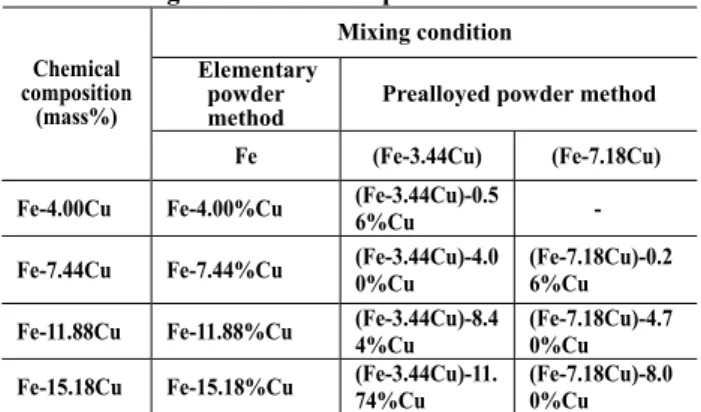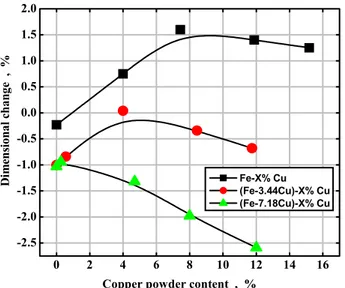© Korean Powder Metallurgy Institute 812
-1. Introduction
In many case sintered compacts showed the shrinkage by sintering progress, but the compact made from iron-copper elemental powder mixture showed a large amount of ex- pansion at the temperatures above copper melting point in the sintering process. This expansion which was called as “copper growth” or “abnormal expansion” has been studied for many years1~4), and its mechanism is mainly explained by the penetration theory that is based on penetration of liquid copper into iron grain boundaries5), but is not yet well understood.
In order to study the mechanism of expansion of iron-copper compacts during sintering process, we investigated the dimensional change of iron-copper compacts made from (Fe-Cu) prealloyed powder with copper content of 3.44mass% and 7.18mass%, and compared the results with that of the compacts made from iron-copper elemental powder mixture which is conventional method. The change of microstructures of iron-copper compacts in sintering process was also investigated.
2. Experimental and Results
As the main raw powders, water atomized pure iron powder (Kawasaki Steel Co., KIP300A) and water atomized iron-copper prealloyed powders [Fukuda Metal Foil and Powder Co., (Fe-3.44Cu) and (Fe-7.18Cu)] with copper content of 3.44mass% and 7.18mass%, and as the additive powder, electrolytic copper powder (Fukuda Metal Foil and Powder Co., CE 8) were used. The particle size of pure iron and prealloyed powders was -100mesh and that of additive
copper powder was -150/+200mesh. The raw powders were mixed for 30 minutes to make homogenous mixtures with chemical composition as shown in Table 1. The mixtures were compacted respectively into cylinder shape (12x5mm) and rectangular shape (5x5x30mm) with a density ratio of about 80% by the pressure of 290~590MPa. The pure iron powder was also compacted under the same compacting condition to compare the dimensional change with those of iron-copper compacts. The specimens were heated up to 1150℃ with a rate of 10℃/min followed by holding at 1150℃ for 60min and cooled down to room temperature with a rate of 20℃/min. Sintering was conducted under the flow of hydrogen with the dew-point of about -20℃ and the flow rate was about 0.7liter/min. Dimensional change, dilatometric curve and microstructures of compact were examined.
Table 1. Mixing condition of raw powders
Mixing condition Elementary
powder
method Prealloyed powder method Chemical
composition (mass%)
Fe (Fe-3.44Cu) (Fe-7.18Cu)
Fe-4.00Cu Fe-4.00%Cu (Fe-3.44Cu)-0.56%Cu - Fe-7.44Cu Fe-7.44%Cu (Fe-3.44Cu)-4.00%Cu (Fe-7.18Cu)-0.26%Cu Fe-11.88Cu Fe-11.88%Cu (Fe-3.44Cu)-8.44%Cu (Fe-7.18Cu)-4.70%Cu Fe-15.18Cu Fe-15.18%Cu (Fe-3.44Cu)-11.74%Cu (Fe-7.18Cu)-8.00%Cu One of the results is shown in Fig 1. In dimensional change of compacts made from only main raw powders
2006 POWDER METALLURGY World Congress
B06-07-3
Expansion Behavior of Iron-copper Compact Made from
(Fe-Cu) Prealloyed Powder
Youn-Che Kim1,a and Myung-Jin Suk1,b 1
Department of Materials and Metallurgical Engineering, Kangwon National University, 1 Joongang-ro Samcheok, Kangwondo, 247-711 Korea
a
yckim@kangwon.ac.kr, bpanpani@kangwon.ac.kr
Abstract
Dimensional change of compact made from (Fe-Cu) prealloyed powder and copper powder compared to that of compact made from iron-copper elemental powder. The compact made from the prealloyed powder with a copper content of 7.18mass% which is nearly equal to its solution limit and copper powder showed only the large contraction in spite of penetration of liquid copper into grain boundary of the prealloyed powder. But the compact made from iron-copper elemental powder showed the large expansion in spite of same chemical composition with former case.
© Korean Powder Metallurgy Institute 813
-without addition of copper powder, pure iron powder (KIP-300A) showed the shrinkage of about 0.25%, but that of (Fe-3.44Cu) prealloyed powder showed the large shrinkage of about 1.0% which was nearly equal to that of (Fe-7.18Cu) prealloyed powder. The compacts made from the prealloyed powders shrank larger than that from pure iron powder under same compacting and sintering conditions, it seems to be mainly due to difference of the particle size distribution as shown in Fig. 2. The prealloyed powder have much more distribution in the range under 350mesh than pure iron powder. Therefore, the compacts made from finer prealloyed powders shrank more than that from coarser pure iron powder.
0 2 4 6 8 10 12 14 16 -2.5 -2.0 -1.5 -1.0 -0.5 0.0 0.5 1.0 1.5 2.0
Copper powder content , %
D im ens io nal c han ge , % Fe-X% Cu (Fe-3.44Cu)-X% Cu (Fe-7.18Cu)-X% Cu
Fig. 1. Effect of copper powder content on dimensional change of compacts made from pure iron powder and from prealloyed powders of (Fe-3.44Cu) and (Fe-7.18Cu), sintered for 60min at 1150℃.
On the other hand, the compact from a mixture of iron- copper elemental powder showed large expansion, and the expansion tendency increased with the increasing of copper powder content up to about 7.4mass%, but became to decrease slightly at the copper powder content above it. Compare with this, the compacts from a mixture of prealloyed powder and copper powder showed the different tendency. The compact from (Fe-3.44Cu) prealloyed powder and copper powder mixture was also expanded with the increasing of copper powder content up to about 4.0mass%, at which showed the maximum expansion, and its maximum expansion became to decrease slightly at the copper powder content above it. But the compact from (Fe-7.18Cu) prealloyed powder and copper powder mixture only contracted with the increasing of copper powder content. Like these the dimensional change of iron-copper compacts showed very different behavior, according as iron raw powder be contained the copper or not, in the spite of the same addition content of copper powder. Such difference in the dimensional change is due to
0 5 10 15 20 25 30 35 40 -350 -300/+350 -250/+300 -200/+250 -150/+200 -100/+150 +100 W ei ght p ercen t , %
Particle size , mesh
KIP-300A (Fe-7.18Cu) (Fe-3.44Cu)
Fig. 2. Comparison of particle size distribution of pure iron powder and prealloyed powders of (Fe-3.44Cu) and (Fe.7.18Cu) as the main raw powder.
be different diffusion of copper into the main raw powder such as pure iron, prealloyed powder of (Fe-3.44Cu) and (Fe-7.18Cu) in sintering process.
3. Summary
Dimensioal change of iron-copper compact showed very different behavior, according as copper content in iron raw powder. The compact made from (Fe-Cu) prealloyed powder and copper powder showed the large contraction by progress of liquid phase sintering, but the compact made from iron-copper elemental powder showed the large expansion by diffusion of copper into iron powder.
4. References
1.H. Mitani and K. Nishigaki : “On Abnormal Expansion in Mixed Compacts of the Fe-Cu Binary System during Sintering”, Journal of the Japan Institute of Metals, 32(1968) 478~482.
2. T. Watanabe and M. Kawaguchi : “Growing Phenomena of Iron-Copper Compacts during Sintering Process”, Transactions of the Casting Research Laboratory Waseda Univ., 27(1973) 65~75.
3. K. Tabcshfar and D. A. Chadwick : “Dimensional Changes during Liquid Phase Sintering of Fe-Cu Compacts”, Powder Metall., 27(1984) 19~24.
4. H. Fredriksson, K. Hansson and A, Olsson : “On the Mechanism of Liquid Copper Penetration into Iron Grain Boundaries”, Scand. J. Metall. Int., 30(2001) 41~50. 5. F. V. Lenel, T. Pecanha : “Observations on the Sintering of Compacts from a mixture of Iron and Copper Powders”, Powder Metall. Int., 16(1973) 351~365.

